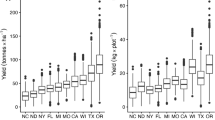Abstract
Usually, genetic selection is carried out based on several traits, which can be genetically correlated. In this case, selection bias may occur if these traits are analyzed individually. Thus, the present work aimed to evaluate the applicability and efficiency of multiple-trait best linear unbiased prediction (BLUP) in the genetic selection of Eucalyptus. The data used in this work refer to the evaluation of a partial diallel of Eucalyptus spp. in relation to height, diameter at breast height (DBH), and volume. Variance components and genetic and non-genetic parameters were estimated via residual maximum likelihood (REML). Multiple-trait BLUP led to estimates of mean additive genetic variance higher than the estimates obtained via single-trait BLUP and, consequently, led to higher estimates of narrow-sense individual interpopulational heritabilities and mean accuracies. Partial genetic correlations obtained via multiple-trait BLUP allowed a real understanding of the association between traits, differently from those obtained via single-trait BLUP. Multiple-trait BLUP led to higher gains predicted with the selection for height, DBH, and volume and can be efficiently applied in the genetic selection of Eucalyptus.
Similar content being viewed by others
References
Alves RS, Peixoto LA, Teodoro PE, Silva LA, Rodrigues EV, Resende MDV, Laviola BG, Bhering LL (2018) Selection of Jatropha curcas families based on temporal stability and adaptability of genetic values. Ind Crop Prod 119:290–293
Bauer AM, Léon J (2008) Multiple-trait breeding values for parental selection in self-pollinating crops. Theor Appl Genet 116:235–242
Cohen J (1960) A coefficient of agreement for nominal scales. Educ Psychol Meas 20:37–46
Corrêa TR, Picoli EAT, Souza GA, Condé SA, Silva NM, Lopes-Mattos KLB, Resende MDV, Zauza EAV, Oda S (2017) Phenotypic markers in early selection for tolerance to dieback in Eucalyptus. Ind Crop Prod 107:130–138
Costa RB, Resende MDV, Gonçalves PS, Silva MA (2002) Individual multivariate REML/BLUP in the presence of genotype x environment interaction in rubber tree (Hevea) breeding. Crop Breed Appl Biotechnol 2:131–140
Costa RB, Silva JC, Skowronski L, Constantino M, Pistori H, Pinto JVC (2016) Genetic divergence in Eucalyptus camaldulensis progenies in the Savanna Biome in Mato Grosso, Brazil. PLoS One 11(9):e0163698
Falconer DS, Mackay TFC (1996) Introduction to quantitative genetics. Longman Group Limited, Edinburgh
Fonseca SM, Resende MDV, Alfenas AC, Guimarães LMS, Assis TF, Grattapaglia D (2010) Practical manual of genetic improvement of Eucalyptus. Editora UFV, Viçosa (in Portuguese)
Gilmour AR, Gogel BJ, Cullis BR, Welham SJ, Thompson R (2015) ASReml User Guide Release 4.1 Structural Specification. VSN International, Hemel Hempstead
Harville DA, Carriquiry AL (1992) Classical and Bayesian prediction as applied to an unbalanced mixed linear model. Biometrics 48:987–1003
Henderson CR (1975) Best linear unbiased estimation and prediction under a selection model. Biometrics 31(2):423–447
Henderson CR, Quaas RL (1976) Multiple trait evaluation using relatives records. J Anim Sci 43(6):1188–1197
Imai A, Kuniga T, Yoshioka T, Nonaka K, Mitani N, Fukamachi H, Hiehata N, Yamamoto M, Hayashi T (2016) Evaluation of the best linear unbiased prediction method for breeding values of fruit-quality traits in citrus. Tree Genet Genomes 12:119
Kerr RJ (1998) Asymptotic rates of response from forest tree breeding strategies using best linear unbiased prediction. Theor Appl Genet 96:484–493
Mrode RA (2014) Linear models for the prediction of animal breeding values. CAB International, Wallingford
Patterson HD, Thompson R (1971) Recovery of inter-block information when block sizes are unequal. Biometrika 58:545–554
Persson T, Andersson B (2004) Accuracy of single- and multiple-trait REML evaluation of data including non-random missing records. Silvae Genet 53(3):135–139
Piepho HP, Mohring J, Melchinger AE, Buchse A (2008) BLUP for phenotypic selection in plant breeding and variety testing. Euphytica 161:209–228
Pollak EJ, Van der Werf J, Quaas RL (1984) Selection bias and multiple trait evaluation. J Dairy Sci 67:1590–1595
R Development Core Team (2018) R: a language and environment for statistical computing. R Foundation for Statistical Computing, Vienna
Resende MDV (2015) Quantitative and population genetics. Suprema, Visconde do Rio Branco (in Portuguese)
Resende MDV (2016) Software Selegen-REML/BLUP: a useful tool for plant breeding. Crop Breed Appl Biotechnol 16:330–339
Resende MDV, Silva FF, Azevedo CF (2014) Mathematical, biometric and computational statistics. Suprema, Visconde do Rio Branco (in Portuguese)
Resende MDV, Ramalho MAP, Carneiro PCS, Carneiro JES, Batista LG, Gois IB (2016) Selection index with parents, populations, progenies, and generations effects in autogamous plant breeding. Crop Sci 56:530–546
Schaeffer LR (2016) Random regression models. Available in http://animalbiosciences.uoguelph.ca/~lrs/BOOKS/rrmbook.pdf
Silveira LCI, Brasileiro BP, Kist V, Weber H, Daros E, Peternelli LA, Barbosa MHP (2015) Selection strategy in families of energy cane based on biomass production and quality traits. Euphytica 204:443–455
Viana JMS, Sobreira FM, Resende MDV, Faria VR (2010) Multi-trait BLUP in half-sib selection of annual crops. Plant Breed 129:599–604
Zhu Y, Wu S, Xu J, Lu Z, Li G, Hu Y, Yang X, Bush D (2017) Genetic parameters for growth traits and stem-straightness in Eucalyptus urophylla x E. camaldulensis hybrids from a reciprocal mating design. Euphytica 213(7):142
Acknowledgements
We wish to thank the Aperam BioEnergia Company for the partnership and the anonymous reviewers for helpful comments on the first version of the paper.
Funding
This study received financial support from the CAPES (Brazilian Federal Agency for Support and Evaluation of Graduate Education) and CNPq (National Council for Scientific and Technological Development).
Author information
Authors and Affiliations
Corresponding author
Additional information
Communicated by J. Beaulieu
Electronic supplementary material
ESM 1
(DOCX 1498 kb)
Data archiving statement
All relevant data are presented in the main paper and in the electronic supplementary material.
Rights and permissions
About this article
Cite this article
Alves, R.S., de Carvalho Rocha, J.R.d.A.S., Teodoro, P.E. et al. Multiple-trait BLUP: a suitable strategy for genetic selection of Eucalyptus. Tree Genetics & Genomes 14, 77 (2018). https://doi.org/10.1007/s11295-018-1292-7
Received:
Revised:
Accepted:
Published:
DOI: https://doi.org/10.1007/s11295-018-1292-7




